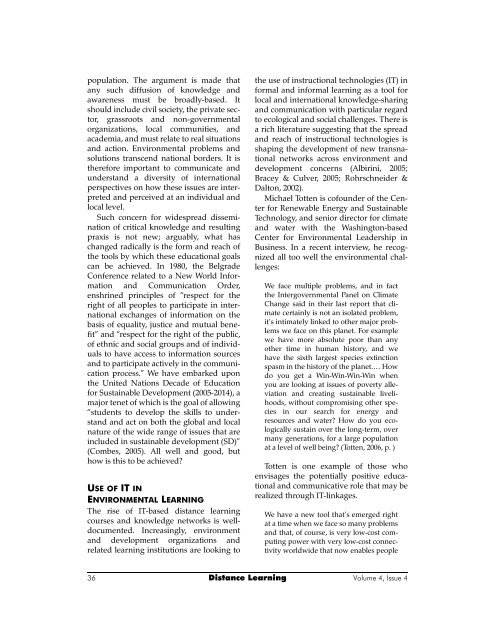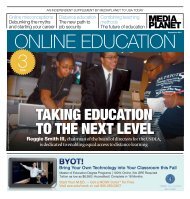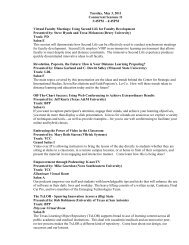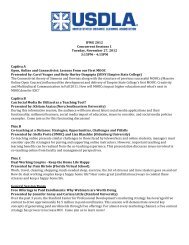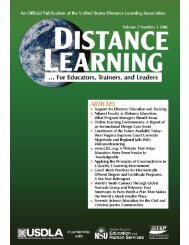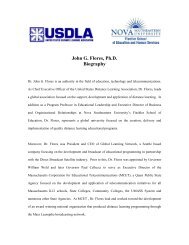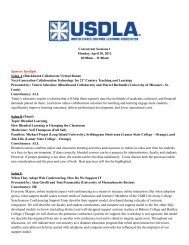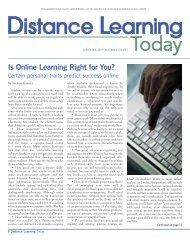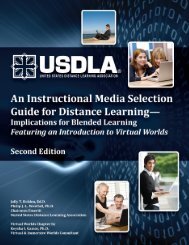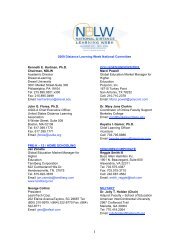United States Distance Learning Association
United States Distance Learning Association
United States Distance Learning Association
- No tags were found...
Create successful ePaper yourself
Turn your PDF publications into a flip-book with our unique Google optimized e-Paper software.
population. The argument is made that<br />
any such diffusion of knowledge and<br />
awareness must be broadly-based. It<br />
should include civil society, the private sector,<br />
grassroots and non-governmental<br />
organizations, local communities, and<br />
academia, and must relate to real situations<br />
and action. Environmental problems and<br />
solutions transcend national borders. It is<br />
therefore important to communicate and<br />
understand a diversity of international<br />
perspectives on how these issues are interpreted<br />
and perceived at an individual and<br />
local level.<br />
Such concern for widespread dissemination<br />
of critical knowledge and resulting<br />
praxis is not new; arguably, what has<br />
changed radically is the form and reach of<br />
the tools by which these educational goals<br />
can be achieved. In 1980, the Belgrade<br />
Conference related to a New World Information<br />
and Communication Order,<br />
enshrined principles of “respect for the<br />
right of all peoples to participate in international<br />
exchanges of information on the<br />
basis of equality, justice and mutual benefit”<br />
and “respect for the right of the public,<br />
of ethnic and social groups and of individuals<br />
to have access to information sources<br />
and to participate actively in the communication<br />
process.” We have embarked upon<br />
the <strong>United</strong> Nations Decade of Education<br />
for Sustainable Development (2005-2014), a<br />
major tenet of which is the goal of allowing<br />
“students to develop the skills to understand<br />
and act on both the global and local<br />
nature of the wide range of issues that are<br />
included in sustainable development (SD)”<br />
(Combes, 2005). All well and good, but<br />
how is this to be achieved<br />
USE OF IT IN<br />
ENVIRONMENTAL LEARNING<br />
The rise of IT-based distance learning<br />
courses and knowledge networks is welldocumented.<br />
Increasingly, environment<br />
and development organizations and<br />
related learning institutions are looking to<br />
the use of instructional technologies (IT) in<br />
formal and informal learning as a tool for<br />
local and international knowledge-sharing<br />
and communication with particular regard<br />
to ecological and social challenges. There is<br />
a rich literature suggesting that the spread<br />
and reach of instructional technologies is<br />
shaping the development of new transnational<br />
networks across environment and<br />
development concerns (Albirini, 2005;<br />
Bracey & Culver, 2005; Rohrschneider &<br />
Dalton, 2002).<br />
Michael Totten is cofounder of the Center<br />
for Renewable Energy and Sustainable<br />
Technology, and senior director for climate<br />
and water with the Washington-based<br />
Center for Environmental Leadership in<br />
Business. In a recent interview, he recognized<br />
all too well the environmental challenges:<br />
We face multiple problems, and in fact<br />
the Intergovernmental Panel on Climate<br />
Change said in their last report that climate<br />
certainly is not an isolated problem,<br />
it’s intimately linked to other major problems<br />
we face on this planet. For example<br />
we have more absolute poor than any<br />
other time in human history, and we<br />
have the sixth largest species extinction<br />
spasm in the history of the planet.… How<br />
do you get a Win-Win-Win-Win when<br />
you are looking at issues of poverty alleviation<br />
and creating sustainable livelihoods,<br />
without compromising other species<br />
in our search for energy and<br />
resources and water How do you ecologically<br />
sustain over the long-term, over<br />
many generations, for a large population<br />
at a level of well being (Totten, 2006, p. )<br />
Totten is one example of those who<br />
envisages the potentially positive educational<br />
and communicative role that may be<br />
realized through IT-linkages.<br />
We have a new tool that’s emerged right<br />
at a time when we face so many problems<br />
and that, of course, is very low-cost computing<br />
power with very low-cost connectivity<br />
worldwide that now enables people<br />
36 <strong>Distance</strong> <strong>Learning</strong> Volume 4, Issue 4


